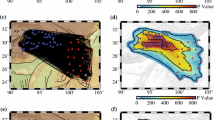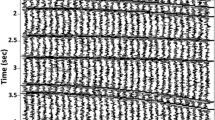Abstract
Understanding the near-surface structure of the Earth requires accurate prediction of physical properties of the subsurface, such as velocity estimated from tomographic inversion of seismic refraction data. The predicted velocity values are often uncertain due to epistemic uncertainty in the inversion process (i.e., imperfectly known underlying physics) and aleatoric variability in the data (i.e., inherent noise in observations). Although seismic refraction is widely used in near-surface applications, the associated uncertainty is rarely quantified and presented alongside the inverted velocity tomograms. In this study, the effect of epistemic uncertainty due to local variability in the initial model and aleatoric variability due to first-arrival picking error on the velocity prediction uncertainty are investigated. A stochastic framework is implemented based on a statistical approach where multiple realizations of stochastically perturbed initial models and travel time picks are generated and the uncertainty in the predicted velocity models is quantified. The two sources of uncertainty are first studied independently and then the combined effect is investigated. The results show that both sources affect the posterior uncertainty, but the uncertainty in the initial model has a greater effect than picking error on the uncertainty of the posterior velocity model. In addition, joint analysis of both sources of uncertainty shows that the uncertainty in the inverted model depends on predicted velocity values, depths, velocity gradients and ray coverages.
















Similar content being viewed by others
Data Availability
Data associated with this research are available and can be access via the following: https://www.hydroshare.org/resource/80467506c1134bd8a66bb3f518dd72ab/.
References
Ackerer J, Steefel C, Liu F, Bart R, Safeeq M, O’Green A, Hunsaker C, Bales R (2020) Determining how critical zone structure constrains hydrogeochemical behavior of watersheds: learning from an elevation gradient in California’s Sierra Nevada. Front Water 2:23
Anderson SP, von Blanckenburg F, White F (2005) Physical and chemical controls on the critical zone. Elements 3(5):315–319
Aster RC, Borchers B, Thurber CH (2018) Parameter estimation and inverse problems. Elsevier, Amsterdam
Bales RC, Dietrich WE (2020) Linking critical zone water storage and ecosystems. Eos. https://doi.org/10.1029/2020EO150459
Befus KM, Sheehan AF, Leopold M, Anderson SP, Anderson RS (2011) Seismic constraints on critical zone architecture, Boulder Creek Watershed, Front Range, Colorado. Vadose Zone J 10:915–927
Borcherdt RD, Healy JH (1968) A method for estimating the uncertainty of seismic velocities measured by refraction techniques. Bull Seismol Soc Am 58(6):1769–1790
Brantley SL, Goldhaber MB, Ragnarsdottir KV (2007) Crossing disciplines and scales to understand the critical zone. Elements 3(5):307–314
Cai A, Zelt CA (2022) Early arrival waveform inversion using data uncertainties and matching filters with application to near-surface seismic refraction data. Geophysics 87(6):465–486
Callahan RP, Riebe CS, Pasquet S, Ferrier KL, Grana D, Sklar LS, Taylor NJ, Flinchum BA, Hayes JL, Carr BJ, Hartsough PC, O’Geen AT, Holbrook WS (2020) Subsurface weathering revealed in hillslope-integrated porosity distributions. Geophys Res Lett 47(15):e2020GL088322
Callahan RP, Riebe CS, Sklar LS, Pasquet S, Ferrier KL, Hahm WJ, Taylor NJ, Grana D, Flinchum BA, Hayes JL, Holbrook WS (2022) Forest vulnerability to drought controlled by bedrock composition. Nat Geosci 15:714–719
Chen J, Zelt CA (2016) Application of frequency-dependent traveltime tomography and full waveform inversion to realistic near-surface seismic refraction data. J Environ Eng Geophys 21(1):1–11
Chen J, Hubbard SS, Gaines D, Korneev V, Baker G, Watson D (2010) Stochastic estimation of aquifer geometry using seismic refraction data with borehole depth constraints. Water Resour Res 46:W11539
Crameri F (2021) Scientific colour maps (7.0.1). Zenodo. https://doi.org/10.5281/zenodo.5501399
Dangeard M, Bodet L, Pasquet S, Thiesson J, Guerin R, Jougnot D, Longuevergne L (2018) Estimating picking errors in near-surface seismic data to enable their time-lapse interpretation of hydrosystems. Near Surf Geophys 16:613–625
Dehoop AT (1966) An elastodynamic reciprocity theorem for linear, viscoelastic media. Appl Sci Res 16:39–45
Dijkstra EW (1959) A note on two problems in connexion with graphs. Numer Math 1:269–271
Efron B (1979) Bootstrap methods: another look at the jackknife. Anal Stat 7(1):1–26
Efron B (1982) The Jackknife, the bootstrap and other resampling plans. SIAM
Flinchum BA, Holbrook WS, Grana D, Parsekian AD, Carr BJ, Hayes JL, Jiao J (2018a) Estimating the water holding capacity of the critical zone using near-surface geophysics. Hydrol Process 32(22):3308–3326
Flinchum BA, Holbrook WS, Rempe D, Moon S, Riebe CS, Carr BJ, Hayes JL, St. Clair J, Peters MP (2018b) Critical zone structure under a granite ridge inferred from drilling and three-dimensional seismic refraction data. J Geophys Res Earth Surf 123(6):1317–1343
Flinchum BA, Holbrook WS, Carr BJ (2022) What do P-wave velocities tell us about the critical zone? Front Water 3:772185. https://doi.org/10.3389/frwa.2021.772185
Gase AC, Bradford JH, Brand BD (2018) Estimation of porosity and water saturation in dual-porosity pyroclastic deposits from joint analysis of compression, shear, and electromagnetic velocities. Geophysics 83(3):ID1–ID11
Grana D, Mukerji T, Doyen P (2021) Seismic reservoir modelling. Wiley, Hoboken
Grana D, Parsekian AD, Flinchum BA, Callahan RP, Smeltz NY, Li A, Hayes JL, Carr BJ, Singha K, Riebe CS, Holbrook WS (2022) Geostatistical rock physics inversion for predicting the spatial distribution of porosity and saturation in the critical zone. Math Geosci 54:1315–1345
Grouveia WP, Scales JA (1998) Bayesian seismic waveform inversion: parameter estimation and uncertainty analysis. J Geophys Res 103(B2):2759–2779
Gu X, Mavko G, Ma L, Oakley D, Accardo N, Carr BJ, Nyblade AA, Brantley SL (2020) Seismic refraction tracks porosity generation and possible CO2 production at depth under a headwater catchment. Proc Natl Acad Sci 117(32):18991–18997
Hahm WJ, Rempe DM, Dralle DN, Dawson TE, Lovill SM, Bryk AB, Bish DL, Schieber J, Dietrich WE (2019) Lithologically controlled subsurface critical zone thickness and water storage capacity determine regional plant community composition. Water Resour Res 55(4):3028–3055
Hayes JL, Riebe CS, Holbrook WS, Flinchum BA, Hartsough PC (2019) Porosity production in weathered rock: Where volumetric strain dominates over chemical mass loss. Sci Adv 5(9):eaao0834
Holbrook WS, Marcon V, Bacon AR, Brantley SL, Carr BJ, Flinchum BA, Richter DD, Riebe CS (2019) Links between physical and chemical weathering inferred from a 65-m-deep borehole through Earth’s critical zone. Sci Rep 9:4495. https://doi.org/10.1038/s41598-019-40819-9
HolbrookWS RCS, Elwaseif ML, Hayes JL, Basler-Reeder KL, Harry DL, Malazian K, Dosseto AC, Hartsough P, Hopmans J (2014) Geophysical constraints on deep weathering and water storage potential in the Southern Sierra critical zone Observatory. Earth Surf Proc Land 39(3):366–380
Huang MH, Hudson-Rasmussen B, Burdick S, Lekic V, Nelson MD, Fauria KE, Schmerr N (2021) Bayesian seismic refraction inversion for critical zone science and near-surface applications. Geochem Geophys Geosyst 22(5):e2020GC009172
Huntoon PW, Lundy DA (1979) Fracture-controlled ground-water circulation and well siting in the vicinity of Laramie, Wyoming. Ground Water 17(5):463–469
Knight R, Endres A (2005) An introduction to rock physics principles for near-surface geophysics. In: Butler DK (ed) Near-surface geophysics. Society of Exploration Geophysicists, pp 31–70
Leopold M, Volkel J, Huber J, Dethier D (2013) Subsurface architecture of the Boulder Creek Critical Zone Observatory from electrical resistivity tomography. Earth Surf Proc Land 38:1417–1431
Liu C, Stock JM (1993) Quantitative determination of uncertainties in seismic refraction processing. Geophysics 58(4):553–563
Marciniak A, Stan-Kleczek I, Idziak A, Majdanski M (2019) Uncertainty based multi-step seismic analysis for near-surface imaging. Open Geosci 11:727–737
Mavko G, Mukerji T, Dvorkin J (2020) The rock physics handbook. Cambridge University Press, Cambridge
McCormick EL, Dralle DN, Hahm WJ, Tune AK, Schmidt LM, Chadwick KD, Rempe DM (2021) Widespread woody plant use of water stored in bedrock. Nature 597(7875):225–229
Moravec BG, White AM, Root RA, Sanchez A, Olshansky Y, Paras BK, Carr B, McIntosh J, Pelletier JD, Rasmussen C, Holbrook WS, Chorover J (2020) Resolving deep critical zone architecture in complex volcanic terrain. J Geophys Res Earth Surf 125:e2019JF005189. https://doi.org/10.1029/2019JF005189
Moysey S, Singha K, Knight R (2005) A framework for inferring field-scale rock physics relationships through numerical simulation. Geophys Res Lett 32(8):L08304
Palmer D (2012) Uncertainty in near-surface refraction inversion. ASEG Ext Abstr 1:1–4
Parsekian AD, Singha K, Minsley BJ, Holbrook WS, Slater L (2015) Multiscale geophysical imaging of the critical zone. Rev Geophys 53:1–26
Parsekian AD, Grana D, Neves F, Pleasants MS, Seyfried M, Moravec BG, Chorover J, Moraes A, Smeltz N, Westenhoff JN, Kelleners T (2021) Hydrogeophysical comparison of hillslope critical zone architecture for different geologic substrates. Geophysics 86(3):1–84
Parsekian AD (2022) Laramie range summer 2022 environmental geophysics. HydroShare. http://www.hydroshare.org/resource/80467506c1134bd8a66bb3f518dd72ab
Prakoso S, Permadi P, Winardhi S, Marhaendrajana T (2018) Dependence of critical porosity on pore geometry and pore structure and its use in estimating porosity and permeability. J Pet Explor Prod Technol 8:431–444
Rawlinson N, Fichtner A, Sambridge M, Young MK (2014) Seismic tomography and the assessment of uncertainty. Adv Geophys 55:1–76
Rempe DM, Dietrich WE (2018) Direct observations of rock moisture, a hidden component of the hydrologic cycle. Proc Natl Acad Sci 115(11):2664–2669. https://doi.org/10.1073/pnas.1800141115
Riebe CS, Hahm WJ, Brantley SL (2017) Controls on deep critical zone architecture: a historical review and four testable hypotheses. Earth Surf Proc Land 42:128–156
Riebe CS, Callahan RP, Granke SBM, Carr BJ, Hayes JL, Schell MS, Sklar LS (2021) Anisovolumetric weathering in granitic saprolite controlled by climate and erosion rate. Geology 49(5):551–555
Robinson DA, Binley A, Crook N, Day-Lewis FD, Ferré T, Grauch V, Knight R, Knoll K, Lakshmi V, Miller R, Nyquist J (2008) Advancing process-based watershed hydrological research using near- surface geophysics: a vision for, and review of, electrical and magnetic geophysical methods. Hydrol Process 18:3604–3635
Rücker C, Günther T, Wagner FM (2017) pyGIMLi: An open-source library for modelling and inversion in geophysics. Comput Geosci 109:106–123
Schnaidt S, Heinson G (2015) Bootstrap resampling as a tool for uncertainty analysis in 2-D magnetotelluric inversion modelling. Geophys J Int 203:92–106
Singha K, Moysey S (2006) Accounting for spatially variable resolution in electrical resistivity tomography through field-scale rock-physics relations. Geophysics 71(4):A25–A28
St. Clair J, Moon S, Holbrook WS, Perron JT, Riebe CS, Martel SJ, Carr B, Harman C, Singha K, Richter D (2015) Geophysical imaging reveals topographic stress control of bedrock weathering. Science 350:534–538
Steinhart JS, Meyer RP (1961) Minimum statistical uncertainty of seismic refraction profile. Geophysics 26(5):574–587
Tarantola A (2005) Inverse problem theory and methods for model parameter estimation. SIAM
White A, Moravec B, McIntosh J, Olshansky Y, Paras B, Sanchez RA, Ferré T, Meixner T, Chorover J (2019) Distinct stores and the routing of water in the deep critical zone of a snow-dominated volcanic catchment. Hydrol Earth Syst Sci 23:4661–4683
Zaytsev V, Biver P, Wackernagel H, Allard D (2016) Change-of-support models on irregular grids for geostatistical simulation. Math Geosci 48(4):353–369. https://doi.org/10.1007/s11004-015-9614-x
Zelt CA, Chen J (2016) Frequency-dependent traveltime tomography for near-surface seismic refraction data. Geophys J Int 207:72–88
Acknowledgements
For field data collection, assistance by L. Schwebs, A. Peterson, and T. Adam is greatly appreciated. This study was supported by the USGS/NIWR and State of Wyoming WWDC through the University of Wyoming Water Research Program. Data associated with this manuscript may be accessed through HydroShare, Parsekian (2022).
Author information
Authors and Affiliations
Corresponding author
Ethics declarations
Conflict of interest
The authors declare that they have no financial nor non-financial conflicts of interest related to this work.
Rights and permissions
Springer Nature or its licensor (e.g. a society or other partner) holds exclusive rights to this article under a publishing agreement with the author(s) or other rightsholder(s); author self-archiving of the accepted manuscript version of this article is solely governed by the terms of such publishing agreement and applicable law.
About this article
Cite this article
Li, A., Grana, D., Parsekian, A.D. et al. Uncertainty Quantification in Tomographic Inversion of Near-Surface Seismic Refraction Data. Math Geosci 56, 77–101 (2024). https://doi.org/10.1007/s11004-023-10083-9
Received:
Accepted:
Published:
Issue Date:
DOI: https://doi.org/10.1007/s11004-023-10083-9




